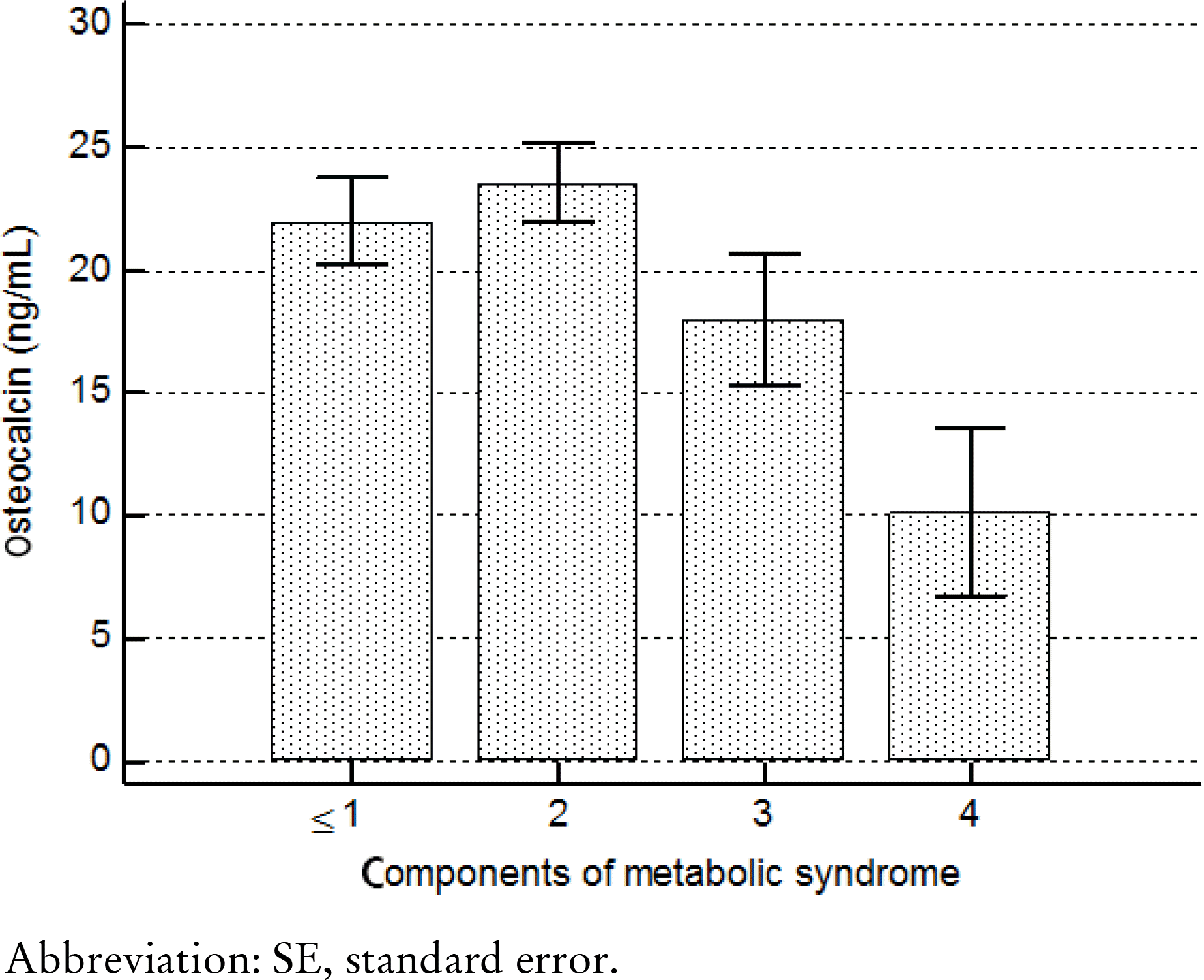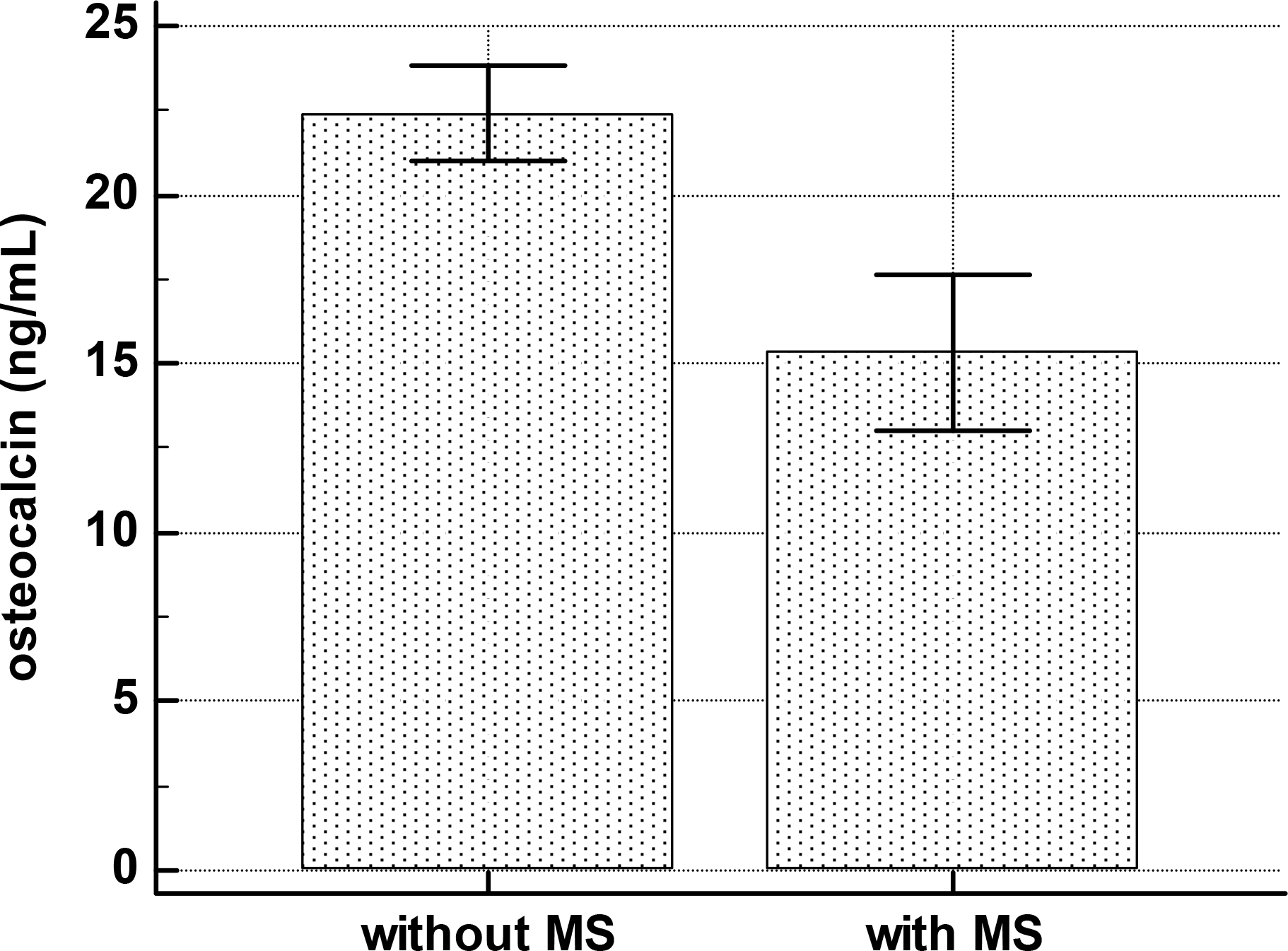Abstract
Background:
Serum osteocalcin level has been widely used as a bone turnover marker in clinical setting. In this study, we analyzed the relationship between serum osteocalcin concentration and metabolic syndrome as a cardiovascular risk factor in adult women.
Methods:
We retrospectively reviewed the medical records of 89 adult women (29 premenopausal, 60 postmenopausal) who voluntarily measured serum osteocalcin concentration and lumbar spine bone mineral density (BMD) for the purpose of screening. The definition of metabolic syndrome was used National Cholesterol Education Program's Adult Treatment Panel III criteria except waist circumference which was adopted the Korean standard.
Results:
The serum osteocalcin concentration with metabolic syndrome was significantly lower than those without metabolic syndrome (15.4±8.0 ng/mL vs. 22.4±12.2 ng/mL; P=0.001). The osteocalcin level was significantly lower in the groups with more than 4 risk factors for metabolic syndrome (10.1±6.7 ng/mL) than the groups with more than 3 (18.0±7.6 ng/mL) or 2 (23.6±7.1 ng/mL) risk factors. As a result of logistic regression analysis using serum osteocalcin, age, menopausal status, lumbar spine BMD and body mass index as independent variables, the presence of metabolic syndrome was independently associated with the serum osteocalcin level (β =-0.151, P=0.018).
Go to : 
REFERENCES
1.Patti A., Gennari L., Merlotti D., Dotta F., Nuti R. Endocrine actions of osteocalcin. Int J Endocrinol. 2013. 2013:846480.

2.Kanazawa I. Osteocalcin as a hormone regulating glucose metabolism. World J Diabetes. 2015. 6(18):1345–54.

3.Im JA., Yu BP., Jeon JY., Kim SH. Relationship between osteocalcin and glucose metabolism in postmenopausal women. Clin Chim Acta. 2008. 396(1-2):66–9.

4.Zhou M., Ma X., Li H., Pan X., Tang J., Gao Y, et al. Serum osteocalcin concentrations in relation to glucose and lipid metabolism in Chinese individuals. Eur J Endocrinol. 2009. 161(5):723–9.

5.Liu JJ., Toy WC., Wong MD., Tan CS., Tavintharan S., Wong MS, et al. Elevated undercarboxylated and reduced carboxylated osteocalcin are associated with metabolic syndrome in middle age Asian females. Exp Clin Endocrinol Diabetes. 2013. 121(6):329–33.

6.Hwang YC., Kang M., Cho IJ., Jeong IK., Ahn KJ., Chung HY, et al. Association between the circulating total osteocalcin level and the development of cardiovascular disease in middle-aged men: a mean 8.7-year longitudinal follow-up study. J Atheroscler Thromb. 2015. 22(2):136–43.

7.Expert Panel on Detection, Evaluation, and Treatment of High Blood Cholesterol in Adults. Executive summary of the third report of the National Cholesterol Education Program (NCEP) expert panel on detection, evaluation, and treatment of high blood cholesterol in adults (Adult Treatment Panel III). JAMA. 2001. 285(19):2486–97.
8.Lee S., Park HS., Kim SM., Kwon HS., Kim DY., Kim DJ, et al. Cut-off points of waist circumference for defining abdominal obesity in the Korean population. Korean J Obes. 2006. 15(1):1–9.
9.Confavreux CB., Szulc P., Casey R., Varennes A., Goudable J., Chapurlat RD. Lower serum osteocalcin is associated with more severe metabolic syndrome in elderly men from the MINOS cohort. Eur J Endocrinol. 2014. 171(2):275–83.

10.Lee SW., Jo HH., Kim MR., Kim JH., You YO. Association between osteocalcin and metabolic syndrome in postmenopausal women. Arch Gynecol Obstet. 2015. 292(3):673–81.

11.Gundberg CM., Looker AC., Nieman SD., Calvo MS. Patterns of osteocalcin and bone specific alkaline phosphatase by age, gender, and race or ethnicity. Bone. 2002. 31(6):703–8.

12.Tan A., Gao Y., Yang X., Zhang H., Qin X., Mo L, et al. Low serum osteocalcin level is a potential marker for metabolic syndrome: results from a Chinese male population survey. Metabolism. 2011. 60(8):1186–92.

13.Holewijn S., den Heijer M., Swinkels DW., Stalenhoef AF., de Graaf J. The metabolic syndrome and its traits as risk factors for subclinical atherosclerosis. J Clin Endocrinol Metab. 2009. 94(8):2893–9.

14.Confavreux CB., Szulc P., Casey R., Boutroy S., Varennes A., Vilayphiou N, et al. Higher serum osteocalcin is associated with lower abdominal aortic calcification progression and longer 10-year survival in elderly men of the MINOS cohort. J Clin Endocrinol Metab. 2013. 98(3):1084–92.

15.Zhang Y., Qi L., Gu W., Yan Q., Dai M., Shi J, et al. Relation of serum osteocalcin level to risk of coronary heart disease in Chinese adults. Am J Cardiol. 2010. 106(10):1461–5.

16.Lee NK., Sowa H., Hinoi E., Ferron M., Ahn JD., Confavreux C, et al. Endocrine regulation of energy metabolism by the skeleton. Cell. 2007. 130(3):456–69.

17.Ferron M., Hinoi E., Karsenty G., Ducy P. Osteocalcin differentially regulates beta cell and adipocyte gene expression and affects the development of metabolic diseases in wild-type mice. Proc Natl Acad Sci U S A. 2008. 105(13):5266–70.
18.Kindblom JM., Ohlsson C., Ljunggren O., Karlsson MK., Tivesten A., Smith U, et al. Plasma osteocalcin is inversely related to fat mass and plasma glucose in elderly Swedish men. J Bone Miner Res. 2009. 24(5):785–91.

19.Fernández-Real JM., Izquierdo M., Ortega F., Gorostiaga E., Gómez-Ambrosi J., Moreno-Navarrete JM, et al. The relationship of serum osteocalcin concentration to insulin secretion, sensitivity, and disposal with hypocaloric diet and resistance training. J Clin Endocrinol Metab. 2009. 94(1):237–45.
Go to : 
 | Figure 2.Serum osteocalcin level according to number of components of metabolic syndrome (mean±SE). |
Table 1.
General characteristics of the subjects
Table 2.
Comparison of osteocalcin levels according to each component of metabolic syndrome
Table 3.
Logistic regression analysis for metabolic syndrome
| Independent variables | Coefficient (β) | P |
|---|---|---|
| Model 1a | ||
| Age, y | -0.005 | 0.936 |
| Menopause | 2.184 | 0.088 |
| Bone mineral density | 2.363 | 0.241 |
| Osteocalcin | -0.154 | 0.014 |
| Model 2b | ||
| Age, y | -0.001 | 0.863 |
| Menopause | 1.861 | 0.191 |
| Bone mineral density | 1.256 | 0.567 |
| Body mass index | 0.254 | 0.013 |
| Osteocalcin | -0.151 | 0.018 |




 PDF
PDF ePub
ePub Citation
Citation Print
Print



 XML Download
XML Download